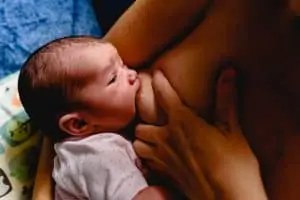Are you preparing for a c-section birth? If so, you might have been told that having a c-section can lead to problems breastfeeding, and that might leave you feeling worried. We’re going to take a look at whether or not a c-section can cause breastfeeding problems.
Before we move further, I want to give you some encouragement. I’ve had four c-sections, and I successfully breastfed all of my children. I ended up using infant formula with my first child after some time, but that was not due to my c-section.
So, any problem that you might encounter is something that you can triumph over. None of these problems are enough to make breastfeeding impossible.
With that being said, let’s take a closer look. Is breastfeeding problems after a c-section myth or reality?
Does Anesthesia Cause Problem with Breastfeeding?
The first thing you might wonder is if anesthesia during the surgery causes breastfeeding complications.
In general, the answer is no. Any anesthesia that you receive shouldn’t affect your milk. A spinal block wears off within six to eight hours post-operation.
As for the pain medication that you take afterward, your doctor should give you medicines that are compatible with breastfeeding. Certain strong pain relievers can increase the sleepiness in you or your baby, so you don’t want to overtake medication.
Excessive sleepiness can be a problem for breastfeeding. Babies need to eat every two to three hours, at maximum, so you’ll need to make sure you wake your sleepy baby. That’s harder than it sounds.
If you happen to have general anesthesia during your surgery, the only problem that you will encounter is a later onset of breastfeeding. That means your baby won’t be able to breastfeed for the first time for several hours after birth.
7 Possible Breastfeeding Problems After a C-Section
Facts do show that women who have c-sections have a higher proportion of breastfeeding difficulties. Studies show 41% of c-section moms have issues breastfeeding compared to the 29% of vaginal birthing mothers.
Delayed First Nursing After Birth
Studies show that babies need to be brought to your breast within the first hour of life. Depending on the hospital where you give birth, some don’t bring your baby to you until an hour or longer after you leave the operating room.
When you wait too long to introduce the breast to your baby, babies have more difficulty breastfeeding, and it can lead to severe engorgement. If you have complications and cannot breastfeed for several hours or a day, it can cause problems breastfeeding later.
Hospitals need to encourage frequent breastfeeding, typically every two hours during the day and no longer than every four hours at night.
Excessive Sleepiness
As mentioned above, taking pain medication can lead to excessive sleepiness, but you need those pain medications. Don’t forget that you had serious surgery, and for your own mental and physical recovery, it’s best to take medicine as your doctor prescribed.
However, if your baby is excessively sleepy, he might not wake up to feed as often as he should. That could lead to failure to gain weight or the loss of too much weight after delivery.
Difficulty Finding A Comfortable Breastfeeding Position
Trust me, recovering from a c-section isn’t comfortable, so finding the right position to breastfeed can be tricky. Finding the correct position is an essential part of nursing your baby, and it can ensure that your baby latches appropriately and transfer milk efficiently.
Experiment as much as possible to get the most comfortable position. You might need to get help from your partner or the hospital staff to find what works best for you.
This is important:
Always make sure that your baby’s tummy is towards you. When you’re in the hospital, you might need a few extra pillows to find the right position. That goes for home as well.

Many mothers find that the side-lying position is more comfortable on the first day or so. It’s easy to breastfeed and rest at the same time, and we know resting is essential after surgery.
Moms Stop Breastfeeding Earlier
Studies show that women who have c-sections are more likely to discontinue breastfeeding before 12 weeks postpartum than those who deliver vaginally. While this might not happen immediately, studies so suggest that c-sections shorten the breastfeeding duration.
Your Milk Might Come in Later
When the placenta separates from the uterus abruptly, it causes an abrupt hormonal shift that signals it’s time for your milk supply to arrive. Moms receive this signal whether or not they have a vaginal or c-section birth.
Note that:
If you have a stressful birth, whether it’s a stressful vaginal or c-section birth, you might notice that your milk comes in a bit later than you might expect. It can take anywhere from two to six days for your milk supply to arrive, with days two to three being the average.
The late arrival of milk might be a direct result of the surgery. It’s hard to determine how our bodies will respond to the trauma of surgery. The other possibility is the late onset of breastfeeding and less frequent breastfeeding sessions.
Recovering at Home
Perhaps one of the trickiest parts of breastfeeding after a c-section is the recovery period. Not only do you need to recover from childbirth, but you also are recovering from serious surgery and learning how to breastfeed your baby. Be sure to let your family know that you need to rest and recover as much as possible.
When you’re in the hospital, you have nurses who ensure you have plenty of alone time, but it’s not as easy when you’re home.
Antibiotics Lead to Yeast
Something you might not realize is that mothers are routinely given antibiotics during and after a c-section to avoid infections. It makes sense!
The problem with this is that there is a connection between a mother taking antibiotics and babies developing thrush. Not only can antibiotics cause an overgrowth of yeast in your vagina, but it also can lead to thrush in your baby’s mouth or a yeast diaper rash, as well as yeast on your nipples.
Breastfeeding with thrush can be painful for both you and your baby. It can lead to sharp, shooting pains in your breast and discomfort for your baby. Moms need to know the signs and symptoms of thrush and yeast diaper rashes. If you know the signs, you can treat it promptly rather than letting it spread.
Preparing to Breastfeed After a C-Section
Yes, we know c-sections can cause problems breastfeeding, but that doesn’t have to occur each time. There are steps you can take ahead of time to make the most of your birth and to decrease any problems that might take place.
Here are some suggestions.
- Try skin to skin in the operating room. Many hospitals now encourage mothers to practice skin to skin during the surgery, right after birth. Your baby can nuzzle at your breast, and he might be able to latch onto your breast if you have help from your partner or the hospital staff.
- Plan to breastfeed in the recovery room. You don’t need to wait until the anesthesia wears off to breastfeed. If you have a spinal block, you are free to breastfeed as soon as you are in your recovery room. I always breastfed my babies within minutes of getting into my room.
- Ask for breastfeeding friendly medication. Pain suppresses milk production while also making it difficult for you to enjoy the birth of your baby thoroughly. Your anesthesiologist and OBGYN can work together to ensure you receive proper medication that takes care of the pain while also being safe for your baby.
- Plan to breastfeed often. One of the most important steps is to plan to breastfeed as often as possible. When your baby is fussy, breastfeed, even if you just fed him. The more you breastfeed, the sooner your milk supply arrives. It also encourages better latching and gets your baby used to breastfeed.
- Try the side-lying breastfeeding position. A hospital lactation consultant or your attending nurse can show you how to breastfeed in this position. This position keeps your baby’s weight off of your incision, while you also can rest and relax. Use plenty of pillows between your back and the side-rail.
- Keep your baby in your room after a c-section. If possible, it’s best for you to room-in with your baby, even after a surgical birth. Your partner can lend a hand in the hospital, along with any visitor. Rooming-in with your baby allows you every opportunity to breastfeed your baby.
Breastfeeding and C-Section Success
Studies show that, while c-section mothers do have a decreased success rate, babies who are born via a c-section can be just as successful at breastfeeding as those who are delivered vaginally. Mothers need to remain committed to breastfeeding to be successful.
Remember that:
It might take longer for mothers and babies to start breastfeeding after a c-section delivery, and your milk might take longer to come in than it would with a vaginal delivery. You will stay longer in the hospital after your c-section than a vaginal birth, so plan to use this time to become more comfortable breastfeeding and learning the best positions for you and your baby.
Hey, this is Linda. My biggest accomplishment in life is being a mother of four children. Their current ages range from almost ten years old down to 20 months old.
I’m passionate about writing parenting articles because I understand so well all of the problems and trials you face as a parent. From breastfeeding woes to budgeting problems and behavior problems, along with everything in between, chances are I’ve faced it over the last ten years. Read more about Linda here.






